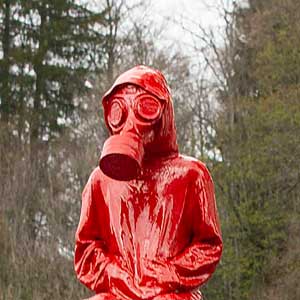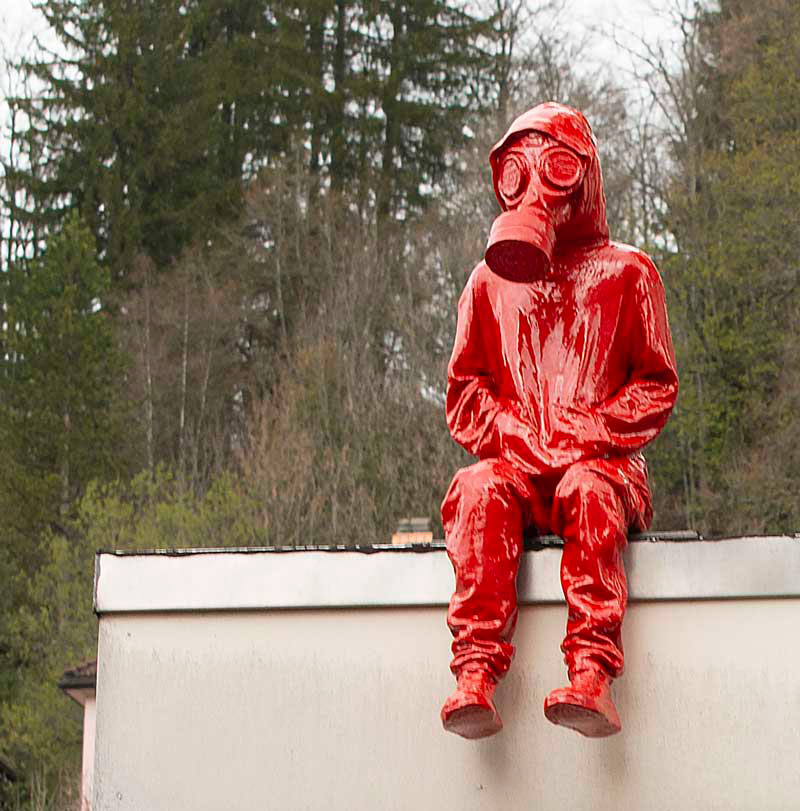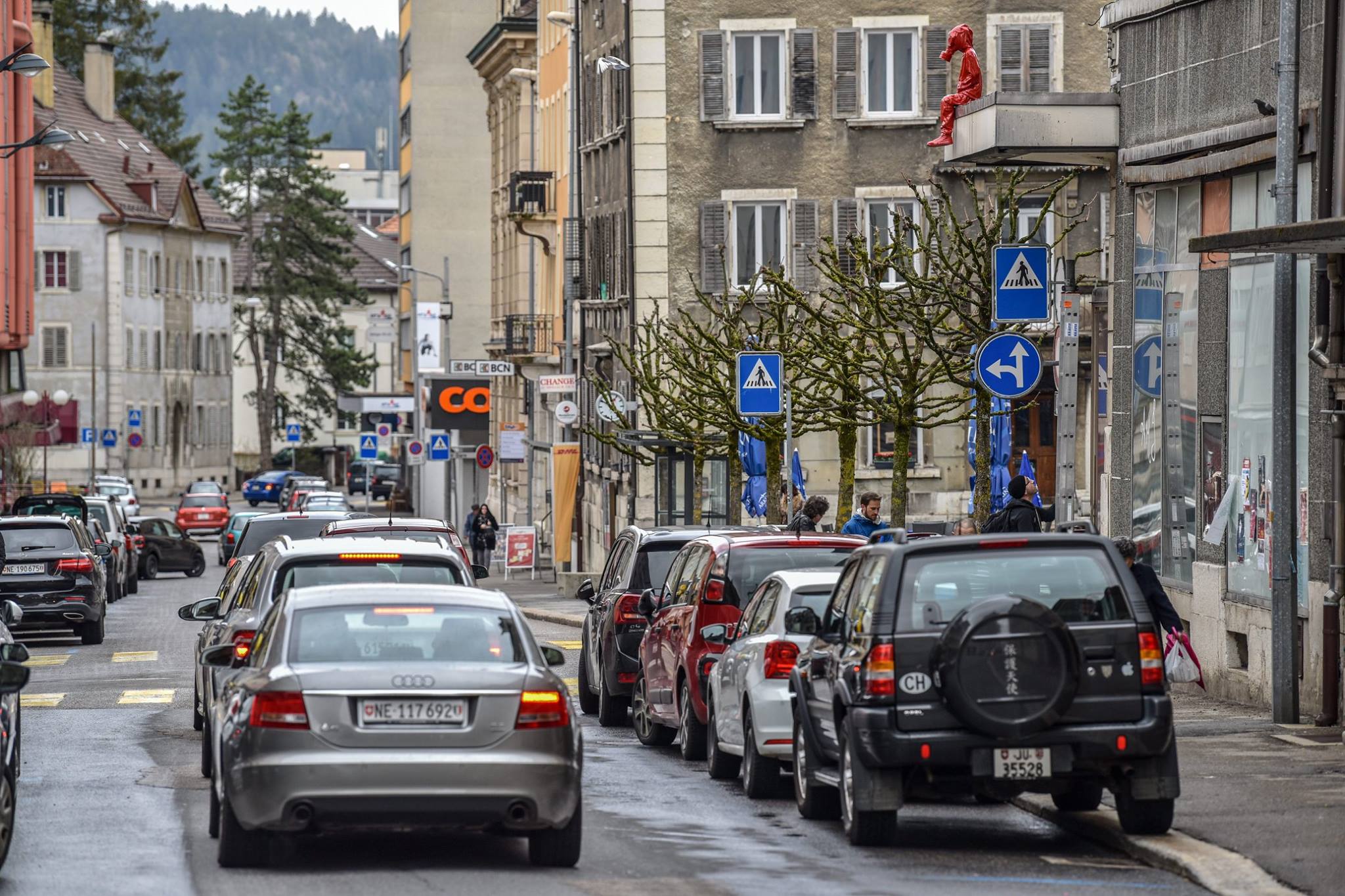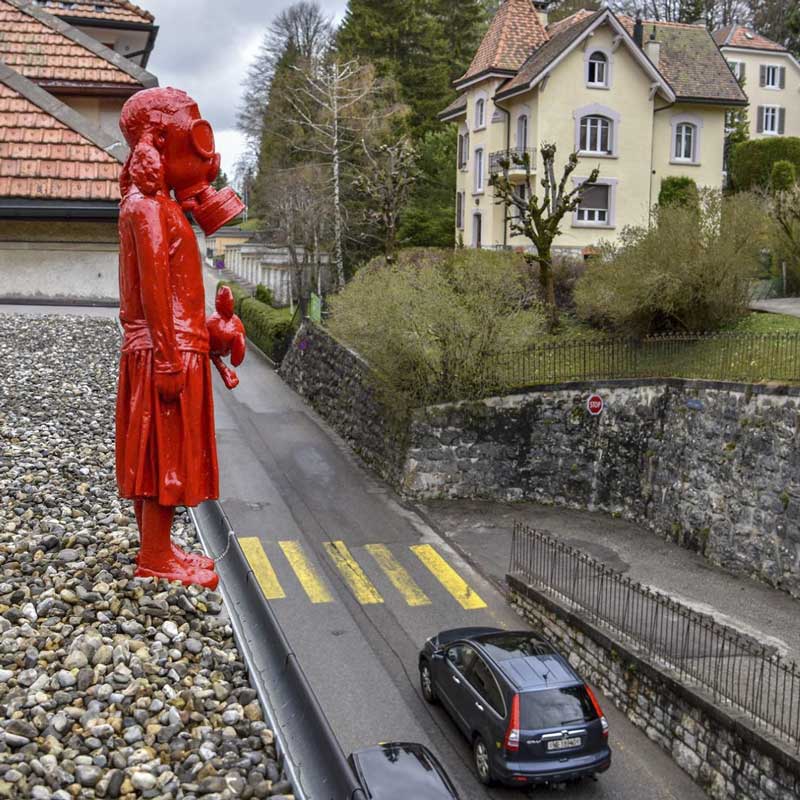James colomina
[FR]
- THE WORKS -
The street as a battlefield
TITLE: L'enfant gazé [THE GASSED CHILD]
Technique: MODELLING, RESIN MOULDING
YEAR CREATED: 2019
LOCATION: Rue du Pont 1
SIZE: 150 x 65 x 65 cm
In Switzerland, official statistics collected between 1980 and 2020 reveal that car traffic doubled in forty years. As there is no way to reverse to this trend, new roads, new bridges and new tunnels are being built practically everywhere. Le Locle, like many towns and cities clogged up with commuter traffic every day, will also get its bypass roads, including a tunnel. Work began in 2021 and will finish in 2030. In the meantime, pedestrians will be champing at the bit waiting to “reclaim the urban space”, according to the popular saying at the start of the third millennium.
On lovely summer evenings, the wind carries the scent of the countryside all the way to the centre of Le Locle. The smell of cut hay. The woody, peaty accents of soil emitted by forests covering the valley sides. When there is no engine sound to disturb the quiet of night, if you close your eyes, it’s possible to imagine the air quality of the preindustrial era when this town was still just a village. But it would be naïve to think that people in Le Locle are breathing in the same air as their forefathers. Because in rush hour, the main roads in the town are congested by a stream of cars and lorries coming from La Chaux-de-Fonds, the Jura, the valley of La Sagne, Val-de-Travers and obviously neighbouring France, the breeding ground of a skilled workforce vital to the local economy. So, outside of public holidays, no fewer than 26,000 vehicles swamp the Le Locle road network every day. “This figure is shocking in terms of pollution, visual nuisance and noise pollution,” says street artist James Colomina. To expose the problems of road traffic faced in the “mother commune”, this visual artist who is concerned with public health issues immediately accepted the exomusée’s proposition to exhibit two of his sculptures of children wearing gas masks.
By placing his two works up high, one on a roof and the other on an awning, the artist forces us to look up. This choice is highly symbolic. Silhouettes of children next to a void inevitably have connotations of danger and challenge us about adults’ capacity to protect minors. Even though they are “just” sculptures, you can’t help worrying about the fate of these youngsters, as if they could suddenly come to life, make a wrong move and fall, or decide to take a step forwards and prematurely leave a world that they consider is on the road to ruin. “Children are born neutral, they don’t know violence. In my works, I’m describing how they’re being manipulated by adults,” comments the artist, himself the father of two young teenagers.
Perched up high, “Colomina’s gassed children” seem to be set apart from society. As if they had put themselves on the fringes of a system that has forgotten or betrayed them. A world that they observe and that they hope to see cleaned up in order to finally be able to get by without gas masks.
James Colomina’s monochrome characters are covered in a varnish to insulate and protect them from environmental damage. Red resin is the artist’s trademark. His bright red urban sculptures are seen as warning signals scattered around the public space as if by a vandal. Both victims and the ones raising the alarm, incarnations of the threats the world faces and symbols of a humanity that needs to be preserved, James Colomina’s creations are designed to be provocative, shocking even.
Rue du Pont 1
- THE ARTIST -
James Colomina

Born in 1974 and originally from Limoux in the Aude, James Colomina speaks with the singsong accent of southern France. Hypersensitive by nature and extremely concerned by issues such as consumerism, mass manipulation, the oppression of children, racism, poverty, the fate awaiting migrants and urban pollution, he took up street art to denounce stupidity and cruelty.
By creating characters that embody the irony of the human condition, James Colomina wants to challenge politicians, question and provoke, indeed shock his peers in order to stimulate debates and reactions. Both victims and the ones raising the alarm, symbols of a humanity that needs to be preserved, his sculptures are made using moulds of the bodies of adults and children into which the artist pours a medical resin with added pigment. James Colomina’s choice of resin comes from his time working as a prosthodontist, a career he gave up following an injury. After trying out white, black, pink, fluorescent green, blue and bright yellow, the artist opted for scarlet. This bright colour, which makes his works highly visible, is intense on an emotional level owing to its connotations with blood and violence, but also love if you think of the symbol of the red heart.
James Colomina has exhibited his works in a large number of cities, including Toulouse, Cannes, Paris, Monaco, London, Miami and New York. Like many street artists who enjoy an international reputation, James is self-taught but there is no difference in the quality of his work compared with those who followed an academic route. His artistic approach is the antithesis of an opportunistic, commercial approach. A humanist to his core, this rising star of street art owes his dazzling career to his work, his talent and his bravery.
In the public space, James Colomina often positions his sculptures without asking for permission, in the purest tradition of street art. In Le Locle, his sculptures were installed with the consent of the authorities and owners involved, in accordance with the exomusée’s charter. In 2019, when the artist came to Le Locle, the commune’s councillor Miguel Perez, then chairman of the town council, helped with the installation of the works. From his perspective, he sees these scarlet silhouettes as a “veiled reference, a beautiful reminder of the battle fought by the authorities to get a bypass for Le Locle and end congestion in the streets”.
To print the content of the page, please click on the printer icon.
- The exo -
on the web
Thank you for following and supporting the exomusée on Facebook, Instagram and YouTube!




